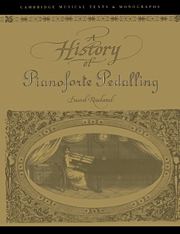Book contents
- Frontmatter
- Contents
- Acknowledgements
- List of abbreviations
- Introduction
- PART I The instruments
- PART II Pedalling and the early pianists
- 3 Documentary accounts of early pedalling
- 4 Early techniques of the pedals as described in tutors
- 5 Early pedal markings
- 6 Mozart and his contemporaries
- PART III Pedalling after c.1800
- APPENDIX: Chapters on pedalling from piano tutors
- Notes
- Select bibliography
- Index
6 - Mozart and his contemporaries
Published online by Cambridge University Press: 16 November 2009
- Frontmatter
- Contents
- Acknowledgements
- List of abbreviations
- Introduction
- PART I The instruments
- PART II Pedalling and the early pianists
- 3 Documentary accounts of early pedalling
- 4 Early techniques of the pedals as described in tutors
- 5 Early pedal markings
- 6 Mozart and his contemporaries
- PART III Pedalling after c.1800
- APPENDIX: Chapters on pedalling from piano tutors
- Notes
- Select bibliography
- Index
Summary
Having examined the development of pedalling in the preceding chapters we must now return to perhaps the most difficult area of all: the way in which first-generation pianists used stops, levers and pedals. The problem is common to all those pianist-composers who were writing music for the new instrument from the middle of the eighteenth century until the appearance of pedal markings in the 1790s. For the modern pianist it is probably most acute in Mozart's case because of his central position in the repertoire, and it is his music that will chiefly occupy us here. Certain questions that arise in the course of this discussion will nevertheless be relevant to the works of his contemporaries, some of whose music is discussed in detail at the end of this chapter.
Mozart
There are no indications of any sort for stops, levers, or pedals in Mozart's music and only one specific reference to such a device in documentary sources. This is contained in a letter which Wolfgang wrote to his father on 17 October 1777 from Augsburg. It is a well-known letter in which he extols the virtues of pianos made by Stein, whom he visited on several occasions. The letter begins with detailed comments on the instruments' action and what appears to be a digest of sales talk by the maker who claimed, amongst other things, to expose his soundboards to the rain, snow and sun so that they could crack and be glued before he inserted them into an instrument. Wolfgang then goes on to describe the earlier events of the day – lunch with Herr Gassner and another visit to Stein.
- Type
- Chapter
- Information
- A History of Pianoforte Pedalling , pp. 82 - 102Publisher: Cambridge University PressPrint publication year: 1993

